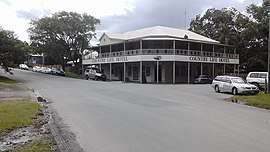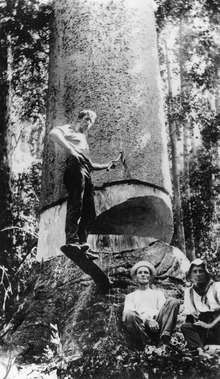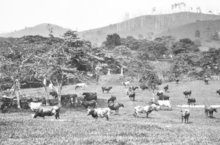Kin Kin
| Kin Kin Sunshine Coast, Queensland | |||||||||||||||
|---|---|---|---|---|---|---|---|---|---|---|---|---|---|---|---|
 The Country Life Hotel on Main Street, Kin Kin, 2018 | |||||||||||||||
 Kin Kin | |||||||||||||||
| Coordinates | 26°15′54″S 152°52′05″E / 26.265°S 152.868°ECoordinates: 26°15′54″S 152°52′05″E / 26.265°S 152.868°E | ||||||||||||||
| Population | 764 (2016 census)[1] | ||||||||||||||
| Postcode(s) | 4571 | ||||||||||||||
| Location | 38 km (24 mi) NW of Noosa Heads | ||||||||||||||
| LGA(s) | Shire of Noosa | ||||||||||||||
| State electorate(s) | Noosa | ||||||||||||||
| Federal Division(s) | Wide Bay | ||||||||||||||
| |||||||||||||||
Kin Kin is a town and locality that lies between Pomona to the south, and Gympie to the north, in South East Queensland, Australia.[2][3] The town is a hub for recreational activities related to nearby Lake Cootharaba and the Great Sandy National Park.[4] Kin Kin is in the Noosa Biosphere[5] Queensland's first UNESCO Biosphere. It is within the local government area of Shire of Noosa (between 2008 and 2013 it was within Sunshine Coast Region).[2][3]
There has long been debate over the origin of the name Kin Kin. It is most widely believed to mean "plenty black ants" after the small black ants very common in the area.[4] [6] [7] This is reflected in the local school newsletter "Kin Kin ANTics" and the large ant sculpture outside the Kin Kin General store, home of Black Ant Gourmet. Some sources suggest the name comes from the Aboriginal kauin kauin meaning red soil. [8][9] In the west of Kin Kin is Woondum National Park and Woondum Forest Reserve. The hills and mountains in this area are covered by eucalypt forest and rainforest.[10]
History


Timber-getters moved into the area in the late 1870s.[4] Until the mid-1970s Kin Kin was predominantly a smallcrop and dairy farming community, from then on land and farm usage started to change and there was a decline in production farms. Early deforestation and clearing of land led to small produce and dairy farming from the early 1900s. The banana industry boomed in the years after World War 1, but experienced a significant decline in the 1930s as prices fell. Beans and Zucchini were major crops for many years, but smallcropping declined from the 1980s and is now undertaken on a limited basis.
The butter factory was closed in 1937[4] but the sawmill still survives. Deregulation of the milk industry led to the exit of all but a handful of family dairy farms. The last farms (in order of closure, Davis, Ferris, and Shepperson) had closed by 2012. Nowadays many original farms have been subdivided into small hobby farms, some growing fruit trees, and many carrying horses or beef cattle. Today Kin Kin boasts health retreats, accommodation, small businesses, artists and bush foods.
The family of William D. Francis one of Queensland's pioneering botanists owned land in the area, and many native trees first identified by him are found in the area.[11]
On 14 August 1971, a tornado passed through the town killing three people.[12] Another tornado hit on February 29 1985, destroying the Butter Factory and causing widespread property damage.[13] On November 4 1994 a severe storm produced large hail and a tornado which damaged or completely destroyed several buildings. [14]
In 2007, a plan to develop a $400 million eco-tourism resort east of Kin Kin was rejected by the Government of Queensland on the grounds that the development was not part of the regional planning document.[15]
In early April 2009 the town was hit by severe flooding [16] from Kin Kin Creek, a tributary of the Noosa River.
Heritage listings
Kin Kin has a number of heritage-listed sites, including:
- Bowman Street: Kin Kin Masonic Lodge [17]
- Grady Street: St Luke's Anglican Church [17]
- Main Street: Kin Kin State School [17]
- Main Street: Kin Kin Memorial School of Arts [17]
- Main Street: Former Post Office [17]
- Main Street: Former ES&A Bank and residence [17]
- Corner Main Street & Wahpunga Road: Country Life Hotel [17]
- Pomona Kin Kin Road: Kin Kin Junction Uniting Church (now a private residence)[17]
- 1 Sister Tree Creek Road: Kin Kin Sawmill [18]
Education
Children from Kin Kin[19] attend a school in Kin Kin village up to grade 6. Secondary school students attend Noosa District State High School: grades 7—8 attend the Pomona campus, and grades 9—12 attend the Cooroy campus.
Amenities
The Shire of Noosa operates a mobile library service on a weekly schedule at the Kin Kin school.[20]
There are public toilets and a playground in the park next to the Memorial School of Arts Hall, and public toilets, a barbecue, and shelter at Wahpunga School Park.
The Kin Kin Tennis Courts are located behind the Memorial School of Arts Hall.
There is a skate park and public camping available on the oval behind the Country Life Hotel.
The Kin Kin Arboretum is located 2.5 km south of the village.
See also
References
- ↑ Australian Bureau of Statistics (31 October 2012). "Kin Kin (Noosa Shire) (State Suburb)". 2011 Census QuickStats. Retrieved 2 February 2013.

- 1 2 "Kin Kin - town in Shire of Noosa (entry 18157)". Queensland Place Names. Queensland Government. Retrieved 3 July 2017.
- 1 2 "Kin Kin - locality in Shire of Noosa (entry 48703)". Queensland Place Names. Queensland Government. Retrieved 3 July 2017.
- 1 2 3 4 Environmental Protection Agency (Queensland) (2000). Heritage Trails of the Great South East. State of Queensland. p. 147. ISBN 0-7345-1008-X.
- ↑ Noosa Biosphere. Retrieved 26 August 2012.
- ↑ Noosa Attractions and Places. 7 January 2007.
- ↑ "MEANING OF KIN KIN AND COOTHARABA". Brisbane Courier (Qld. : 1864 - 1933). 1933-03-11. p. 11. Retrieved 2018-02-15.
- ↑ South East Queensland - Place Names. 19 December 2006.
- ↑ Noosa Community Guide 2005 Part D Archived 24 July 2008 at the Wayback Machine.. 19 December 2006.
- ↑ "About Woondum". Department of National Parks, Recreation, Sport and Racing. 7 January 2013. Retrieved 14 October 2014.
- ↑ Noosa Shire Historical Cultural Heritage Kin Kin July 2002. 2 January 2007.
- ↑ "Drought, Dust and Deluge: Severe Storms: Tornadoes". Bureau of Meteorology. Archived from the original on 24 March 2012. Retrieved 3 February 2013.
- ↑ "Our big bashes: storms that smashed the Coast". Sunshine Coast Daily. Retrieved 2018-01-25.
- ↑ "Brisbane Storm Chasers- Tornadoes in SE Qld".
- ↑ "Anger over Kin Kin development rejection". ABC News. Australian Broadcasting Corporation. 18 June 2007. Retrieved 24 August 2012.
- ↑ Robert Blackmore & Sara Hicks (8 April 2009). "Flood damage and isolation in Kin Kin". ABC Sunshine Coast. Australian Broadcasting Corporation. Retrieved 24 August 2012.
- 1 2 3 4 5 6 7 8 "SCHEDULE 3—HERITAGE SITES" (PDF). Noosa Shire Council. October 2016. Retrieved 28 February 2018.
- ↑ "Kin Kin Sawmill (entry 602686)". Queensland Heritage Register. Queensland Heritage Council. Retrieved 14 July 2013.
- ↑ Kin Kin State School. Department of Education and Training. Retrieved 26 August 2012.
- ↑ "Noosa Mobile Library - Mobile Stops - Noosa Mobile Hours". Shire of Noosa. Retrieved 19 January 2018.
External links
| Wikimedia Commons has media related to Kin Kin, Queensland. |